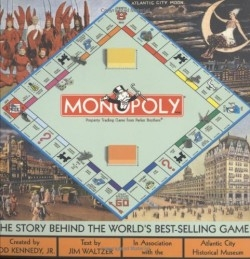Monopoly
The Story Behind the Worlds Best-Selling Game
Donald Trump may owe something to hours spent over a Monopoly board in his early years. His personality, his TV series, and his own recently introduced board game suggest that board-game play has motivated his boardroom exploits.
The central element in such games as his and Monopoly is cutthroat competitiveness without actual loss of blood or financial ruin, and this book offers Monopoly fans a bank vault full of fascinating background information. The volume is packed with stories and nuggets of esoteric data relating to Monopolys creation and early life, how it was affected by its years as a “folk game,” its stint as a favorite of college students before it appeared on the market, and its many links-some quite subtle-to Atlantic City, New Jersey.
Co-author Kennedy is transparently a fervent admirer of that city, with a keen interest in its colorful history. Among his earlier books are Atlantic City: 125 Years of Ocean Madness, The Brooklyn Cookbook, and Lost New York in Old Postcards. Waltzers credits include more than 600 articles in national and regional magazines and one book, Tales of New Jersey.
The Atlantic City connection manifests itself most clearly in regard to Monopolys properties, which the book addresses color by color, beginning with the “Dark Purples”-Baltic and Mediterranean Avenues, the least expensive properties on the board. When Monopoly was created, Waltzer says, Mediterranean was “largely a commercial, light-industrial stretch that featured the likes of Abbotts Dairies and Wrigleys Chewing Gum, and ended with Hackneys seafood restaurant on Absecon Inlet.” Baltic Avenue, he explains, was known for offering accommodations to many of the kitchen and housekeeping workers employed by the hotels near and on the Boardwalk.
For serious-minded Monopoly players, the book also provides knowledgeable advice on property development. With regard to the Dark Purples, a statistical analysis of value (based on cost, rents, and frequency of stops by other players), an opponents trip around the board returns an average of fourteen cents on each investment dollar made by a landlord who has built a hotel on them. The Light Blues, in comparison, return twenty-one cents per dollar invested.
The book is also liberally illustrated with old postcards from Atlantic Citys heyday showing its most spectacular mansions and even more spectacular hotels, such as The Plaza, at Park Place, and the palatial Blenheim, on the Boardwalk. In brief, Monopoly is a treasure trove for trivia lovers. The best tidbit of all, probably, is the boards one spelling error-Marvin Gardens, which is supposed to be Marven, being a combination of the first syllables of Margate and Ventnor townships, through which the Yellows run.
Reviewed by
Harold Cordry
Disclosure: This article is not an endorsement, but a review. The publisher of this book provided free copies of the book to have their book reviewed by a professional reviewer. No fee was paid by the publisher for this review. Foreword Reviews only recommends books that we love. Foreword Magazine, Inc. is disclosing this in accordance with the Federal Trade Commission’s 16 CFR, Part 255.

